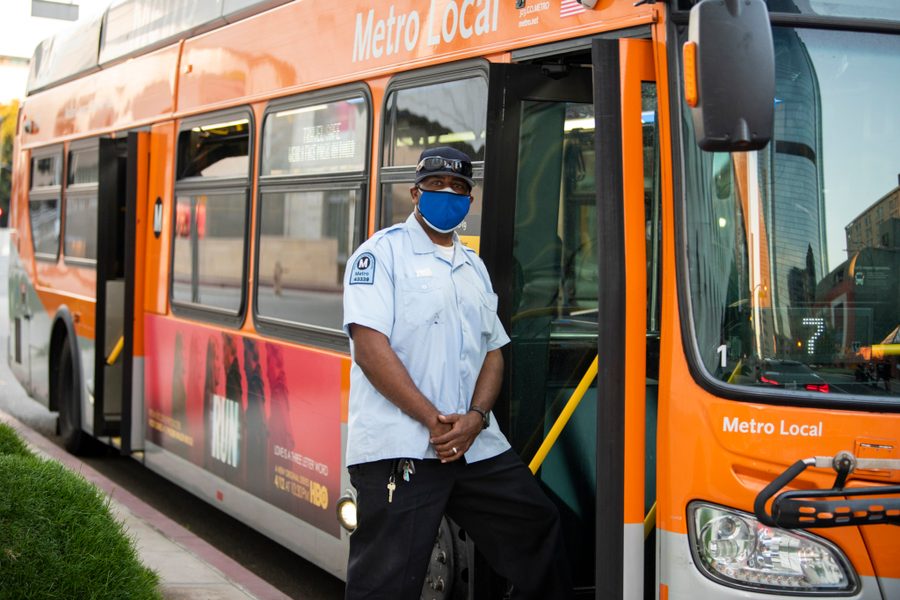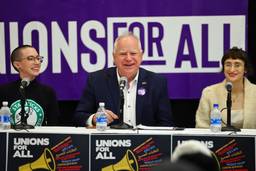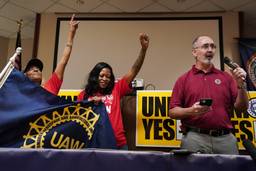
All eyes are on essential workers during the coronavirus pandemic, as individuals, companies and even the federal government make a point to thank them for their heroic action: working. Frontline workers have received plenty of symbolic accolades, but many are working without proper personal protective equipment (PPE) and hazard pay, and are scared for their health and safety. Public transit workers, who shuttle other essential workers to and from work, have been sounding the alarm about poor safety standards at their jobs since the beginning of the coronavirus pandemic. The Amalgamated Transit Union (ATU), which represents 200,000 workers in the United States and Canada, told In These Times that nearly 1,000 of its members have been infected with coronavirus, and almost 40 have died. In response, the union has taken action by setting up coronavirus test sites, sharing information about safety gear, and lobbying both the federal and state governments to do more to protect transit workers. It has also partnered with the Transport Workers Union of America (TWU) to increase its strength.
But the best way for workers to show their strength is to withhold their labor, and ATU locals across the country are engaging in work stoppages to make sure transit agencies understand what’s at stake if they don’t take immediate action to protect workers and riders. Bus drivers in Detroit kicked off the wave of workplace actions on March 17, relatively early in the pandemic, by shutting down bus service throughout the city, leaving only 10% of buses running. They won all of their demands around health and safety, including suspension of fares, rear door entrance, and PPE for drivers — but unfortunately, at least one bus driver has died from coronavirus. (ATU International President John Costa says that transport workers “have been the biggest casualty from this pandemic.”)
Several Birmingham drivers took action next and refused to work on March 23, in order to make the transit authority increase safety. They went back to work the following day after having won multiple safety measures, including a mandate that passengers only use the rear door when boarding and exiting buses, physical barriers around the operator seating area to give drivers social distance from riders, and only allowing 15 to19 passengers on each bus, depending on size of the bus. Gregory Roddy, President of ATU Local 725 in Birmingham, told In These Times that bus drivers “are here ready to work. But we will not work in an unsafe environment.”
Drivers in Richmond, Virginia and Greensboro, North Carolina also took action for safety on the job the following month. On April 27, about 50 drivers in Richmond caused massive service delays by calling out of work to demand hazard pay, in addition to other safety precautions, like PPE, on-site testing, and furlough protections. Two days later, bus service was stopped in Greensboro as some drivers refused to show up at work after a fellow driver tested positive for Covid-19. The transit authority sanitized buses and workspaces, and drivers returned to work the following day. Roddy shared that the coronavirus pandemic has inspired Alabama bus drivers to take action, and that their next fight is for hazard pay. Roddy said that “one person can be broken, but all of us together, we can be strong.”
Layoffs have swept the nation and transit workers are not immune: They have also been laid off and furloughed. President Costa said that without federal intervention, layoffs and cuts to mass transit could continue, long after the pandemic. But he also said his members are ready to fight back: “If we can build ships and bombs, we can transfer money back into the public transit system to keep the cities alive.”
The coronavirus pandemic has opened up new conversations about the future of public transit — in mostly scary ways, unless workers organize to take more control. Because so many people are now either laid off or working from home, ridership is down by 75% nationwide, according to statistics from the Transit App company, so bus lines have been cut, and trains come less frequently. And because numerous cities like New York and Philadelphia are pushing austerity budgets in response to deficits caused by the pandemic, many workers, riders and transit and environmental advocates are concerned that public transportation won’t be restored to its previous level of service. This could leave thousands of union members out of work, and countless others struggling to get to work, school and appointments on time.
But there are also openings to create a better, healthier future, as the pandemic has forced many of us to reckon with the past and imagine a new world. And as the coronavirus crisis has rocked our society, carbon dioxide emissions are projected to drop by about 8% this year. Businesses are closed, air travel has decreased, and millions of people are stuck at home, limiting emissions — for now. Going back to business as usual is not an option for the climate — and it’s not an option for workers either. This is not to argue that the pandemic is in any way a good thing: There is no doubt that the pandemic has ravaged our society, and there’s no way to spin that positively.
The coronavirus crisis is a wakeup call for the climate crisis, which will be far worse. Our only choice is to reimagine our society — to make jobs safer, and to massively invest in public transit, in order to help workers through this crisis and mitigate the climate crisis, which is poised to be far worse. Because of coronavirus, the fossil fuel industry is in total disarray, with prices collapsing and demand falling. By increasing public transportation, we can continue decreasing carbon dioxide emissions, even when businesses begin to reopen and more people go back to work. This is also an opportunity to create more good, union jobs — especially when unemployment is at nearly 25%. Bus drivers have already proven that they’re willing to take action to fight for health and safety on the job — and win. But what else can transport workers struggle for?
ATU says its “members already know that public transit is far more environmentally sustainable.” The union obviously supports expanding public transit — that means more workers, and more members — but it also supports making it free and powering it by the wind, sun, and seas. A retiree from Local 732 in Georgia, Paul McLennan, agrees that “it’s a no brainer. We need more public transit to get people out of cars.” Building and using electric-powered buses and moving away from fossil fuels would of course be gigantic undertakings for the union, but there’s really no other choice if we have any hope of a real future for our climate. The union choosing to prioritize fighting for expanded public transit — and fighting against austerity — opens up doors to work with environmental groups and free transit advocates, and to build the coalition necessary to actually win these huge demands. We’ve already seen this coalition at work during coronavirus — 350.org, Sierra Club, and Sunrise Movement joined with ATU and TWU to demand that Congress increase the allocation for emergency assistance to public transportation.
This work is no small feat, but President Costa said that “we’ve been shut down for six weeks. Oil is worthless, they’re giving it away. Now the air is better, the world is cleaner. It pays to have a good and safe transit system in our world, and the Green New Deal means creating better jobs.” If we want to transition to a more just society, transport workers’ jobs must be safe and dignified, and we have to create more of them by expanding public transit. In the words of McLennan, “when we see problems from all sides, it makes for better solutions.”








